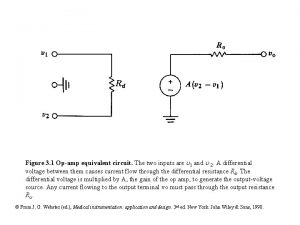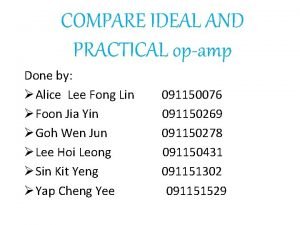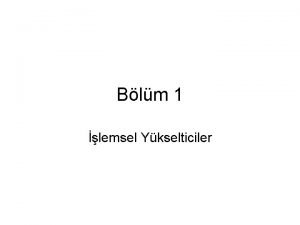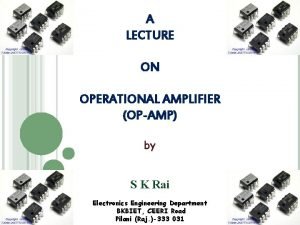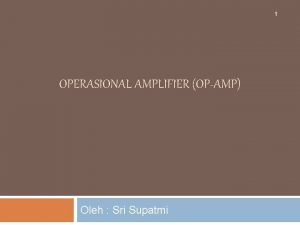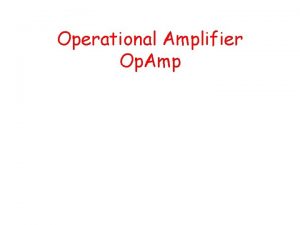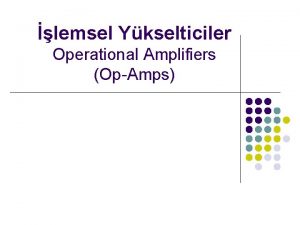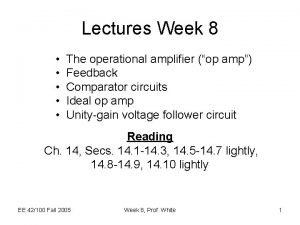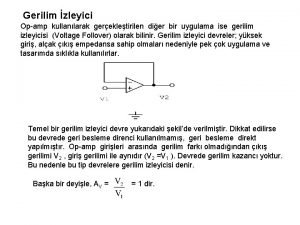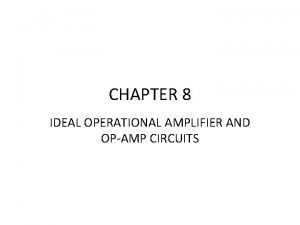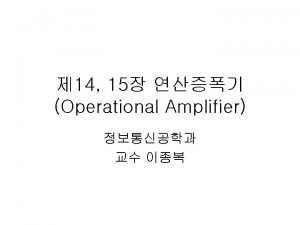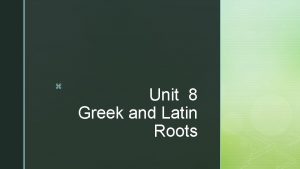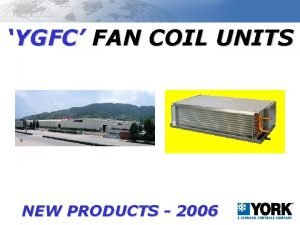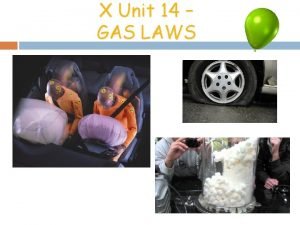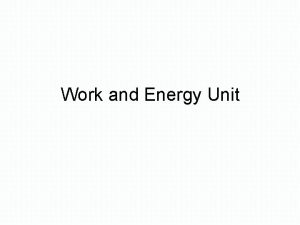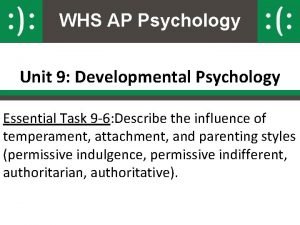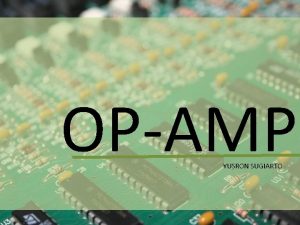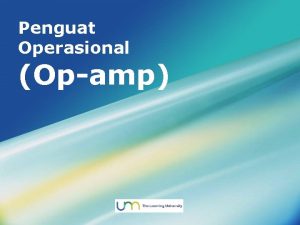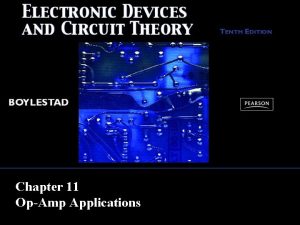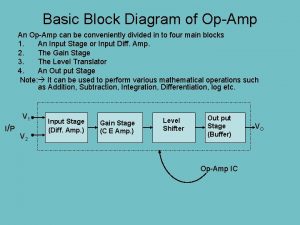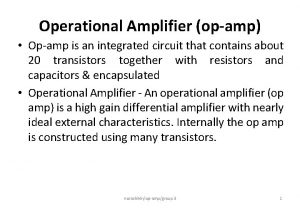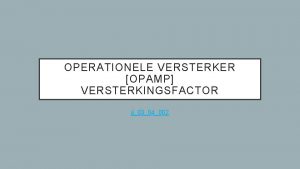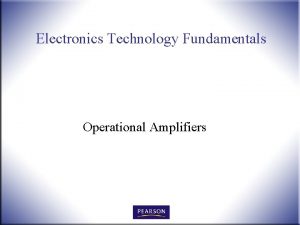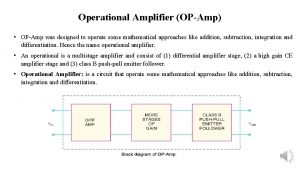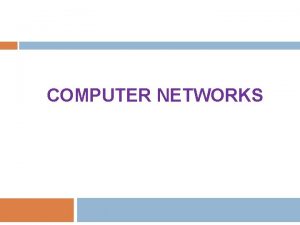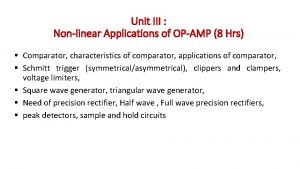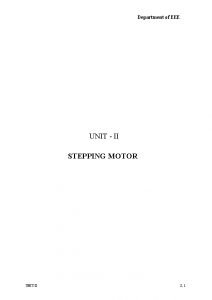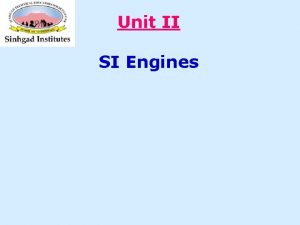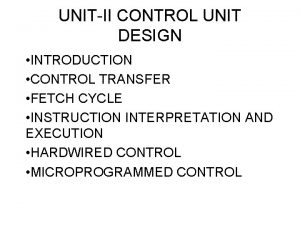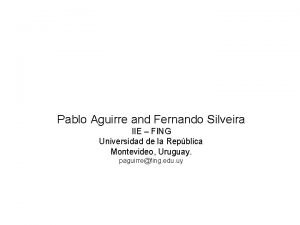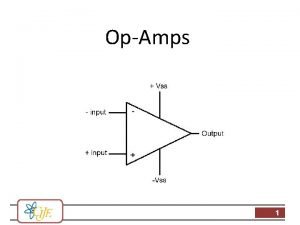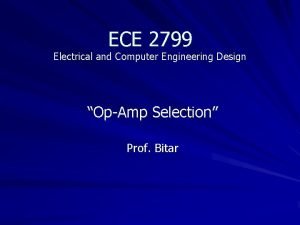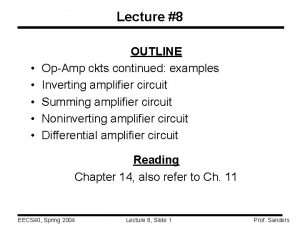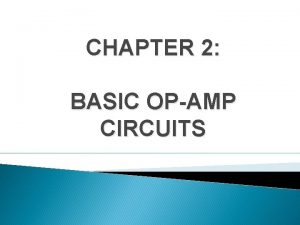UNITII Characteristics of OpAmp UNIT II CHARACTERISTICS OF


































- Slides: 34

UNIT-II Characteristics of Op-Amp UNIT II CHARACTERISTICS OF OPAMP Ideal OP-AMP characteristics, DC characteristics, AC characteristics, , differential amplifier; frequency response of OP-AMP; Basic applications of op -amp – Inverting and Non-inverting Amplifiers-V/I & I/V converters , summer, differentiator and integrator. 1 KIOT-Department of EEE ; LIC/UNIT -2

OPERATION AMPLIFIER 2 KIOT-Department of EEE ; LIC/UNIT -2

3 KIOT-Department of EEE ; LIC/UNIT -2

Op-amp • Terminals (2 i/p ; 2 supply ; 1 o/p) • DC offset null terminal 2 • Power Range ± 5 V to ± 22 v KIOT-Department of EEE ; LIC/UNIT -2 KIOT-Department of EEE ; LIC/UNIT -2 4

Internal circuitry of 741 5 KIOT-Department of EEE ; LIC/UNIT -2

Ideal characteristics of OPAMP 1. 2. 3. 4. 5. Open loop gain infinite Input impedance infinite Output impedance low Bandwidth infinite Zero offset, ie, Vo=0 when V 1=V 2=0 6 KIOT-Department of EEE ; LIC/UNIT -2

-ve Feedback As the open loop DC gain of an operational amplifier is extremely high Feedback is the process of “feeding back” a fraction of the output signal back to the input. but to make the feedback negative, we must feed it back to the negative or “inverting input” terminal of the op-amp using an external Feedback Resistor called Rƒ. This feedback connection between the output and the inverting input terminal forces the differential input voltage towards zero. 7 KIOT-Department of EEE ; LIC/UNIT -2

Inverting Op-Amp Circuit that amplifies i/p and provides o/p with 180º phase shift. KIOT-Department of EEE ; LIC/UNIT -2 KIOT-Department of EEE ; LIC/UNIT -2 8

Inverting Op-Amp 9 KIOT-Department of EEE ; LIC/UNIT -2

Non-Inverting Amplifier • Circuit that amplifies i/p and provides o/p without any phase shift. • Value of R 1 is very large as op-amp draws –ve current from signal source. • Rf and R 1 forms potential divider. Rf 10 KIOT-Department of EEE ; LIC/UNIT -2

Non-Inverting Amplifier 11 KIOT-Department of EEE ; LIC/UNIT -2

Voltage follower • o/p is equal to i/p in both magnitude and phase. • o/p follows i/p. • i/p impedance is high (MΩ) ; • o/p impedance is Zero. • Used as buffer for impedance matching. 12 KIOT-Department of EEE ; LIC/UNIT -2

Voltage follower 13 KIOT-Department of EEE ; LIC/UNIT -2

DC characteristics Practical OP-AMP characteristics does not match ideal OP-AMP • Due to temperature • Internal transistor mismatch. DC characteristics : 1. 2. 3. 4. Input bias current Input offset voltage Thermal drift 14 KIOT-Department of EEE ; LIC/UNIT -2

DC characteristics Input bias current IB as the average value of the base currents entering into terminal of an op-amp Ø Ideal opamp – no current drawn through i/p terminal. Ø But practically, input do conduct small current. Ideally, if vi=0; vo should be 0 ; but vo=(IB+)Rf (IB+) - The Small input current cause o/p voltage across vo 15 KIOT-Department of EEE ; LIC/UNIT -2

DC characteristics Input bias current This effect can be compensated by adding a compensation resistor Rcomp. 16 KIOT-Department of EEE ; LIC/UNIT -2

DC characteristics Input offset current The difference between the bias currents at the input terminals of the op- amp is called as input offset current. The input terminals conduct a small value of dc current to bias the input transistors. Since the input transistors cannot be made identical, there exists a difference in bias currents 17 KIOT-Department of EEE ; LIC/UNIT -2

DC characteristics Input offset voltage A small voltage applied to the input terminals to make the output voltage as zero when the two input terminals are grounded is called input offset voltage. 18 KIOT-Department of EEE ; LIC/UNIT -2

DC characteristics Thermal Drift Bias current, offset current and offset voltage change with temperature. A circuit carefully nulled at 25 oc may not remain so when the temperature rises to 35 oc. This is called drift. 19 KIOT-Department of EEE ; LIC/UNIT -2

AC characteristics Frequency Response HIGH FREQUENCY MODEL OF OPAMP 20 KIOT-Department of EEE ; LIC/UNIT -2

AC characteristics Frequency Response OPEN LOOP GAIN VS FREQUENCY 21 KIOT-Department of EEE ; LIC/UNIT -2

Need for frequency compensation in practical op-amps • Frequency compensation is needed when large bandwidth and lower closed loop gain is desired. • Compensating networks are used to control the phase shift and hence to improve the stability 22 KIOT-Department of EEE ; LIC/UNIT -2

Frequency compensation methods • Dominant- pole compensation • Pole- zero compensation 23 KIOT-Department of EEE ; LIC/UNIT -2

Slew Rate • The slew rate is defined as the maximum rate of change of output voltage caused by a step input voltage. • An ideal slew rate is infinite which means that op-amp’s output voltage should change instantaneously in response to input step voltage 24 KIOT-Department of EEE ; LIC/UNIT -2

Differentiator • Performs mathematical operation of differentiation. • O/P wave is the derivative of I/P wave. 25 KIOT-Department of EEE ; LIC/UNIT -2

26 KIOT-Department of EEE ; LIC/UNIT -2

Integrator • Performs mathematical operation of integration. • O/P proportional to time integral of I/P & R 1 Cf. 27 KIOT-Department of EEE ; LIC/UNIT -2

28 KIOT-Department of EEE ; LIC/UNIT -2

Differential amplifier 29 KIOT-Department of EEE ; LIC/UNIT -2

Differential amplifier • Circuit that amplifies the difference between the two i/p signal and provides o/p. • Used in instrumentation amplifier. 30 KIOT-Department of EEE ; LIC/UNIT -2

Differential amplifier (R 2 / R 1) is Gain; ie if R 2=100 R 1 then Vd is Amplified 100 times. 31 KIOT-Department of EEE ; LIC/UNIT -2

Summer • Output is inverted sum of the inputs. 32 KIOT-Department of EEE ; LIC/UNIT -2

Summer Output is Sum of input If R 1= R 2= R 3= Rf Output is Average of input If R 1= R 2= R 3= 3 Rf 33 KIOT-Department of EEE ; LIC/UNIT -2

KIOT-Department of EEE ; LIC/UNIT -2 34
 Equivalent circuit of op amp
Equivalent circuit of op amp Difference between ideal and real op amp
Difference between ideal and real op amp Op amp sembolü
Op amp sembolü Virtual ground concept
Virtual ground concept Rumus vout op amp
Rumus vout op amp How op amp works
How op amp works Opamp
Opamp Opamp
Opamp Opamp
Opamp Op amp circuits examples
Op amp circuits examples Virtual ground in op-amp
Virtual ground in op-amp Unit 10, unit 10 review tests, unit 10 general test
Unit 10, unit 10 review tests, unit 10 general test Metode pembiayaan semi langsung
Metode pembiayaan semi langsung Unit 4 lesson 7 right triangles and trigonometry unit test
Unit 4 lesson 7 right triangles and trigonometry unit test English unit conversion
English unit conversion Unit test unit test review algebra 2
Unit test unit test review algebra 2 Perhitungan unit cost rekam medis
Perhitungan unit cost rekam medis Unit process and unit operation
Unit process and unit operation What is unit operation and unit process
What is unit operation and unit process Kerangka konseptual standar akuntansi pemerintahan
Kerangka konseptual standar akuntansi pemerintahan Characteristics of statistical unit
Characteristics of statistical unit Unit 8 vocabulary from latin and greek roots
Unit 8 vocabulary from latin and greek roots Ygfc york
Ygfc york What happens to gas when the temperature decreases
What happens to gas when the temperature decreases Ke pe
Ke pe Potential energy formula
Potential energy formula Explain factors to consider when proposing dishes for menus
Explain factors to consider when proposing dishes for menus External forms of social control criminology
External forms of social control criminology Criminology unit 4 notes
Criminology unit 4 notes Wjec criminology unit 2 revision
Wjec criminology unit 2 revision Unit 3 english language
Unit 3 english language Criminology unit 4 quiz
Criminology unit 4 quiz Heat capacity
Heat capacity Temperament ap psychology
Temperament ap psychology Initiative vs guilt
Initiative vs guilt
